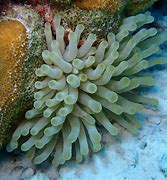
Sea Anemone
Sea anemones are fascinating marine animals belonging to the class Anthozoa, which also includes corals and jellyfish. Here are some interesting facts about sea anemones:
Appearance: Sea anemones have a cylindrical body with a base attached to a substrate and a column topped by a crown of tentacles. The tentacles are typically arranged in concentric circles around the mouth, giving them a flower-like appearance. They come in a variety of colors, including shades of red, green, blue, and purple.
Habitat: Sea anemones are found in both saltwater and brackish environments around the world, from shallow intertidal zones to deep ocean waters. They can be found attached to rocks, coral reefs, or other surfaces in areas with suitable water conditions and abundant food.
Predatory Behavior: Sea anemones are carnivorous predators. They use their venomous tentacles to capture small fish, plankton, and other invertebrates that come into contact with them. Once prey is captured, the tentacles bring it to the mouth, where it is digested.
Symbiotic Relationships: Sea anemones are known for their symbiotic partnerships with various organisms. The most well-known association is with clownfish. The clownfish seek refuge within the stinging tentacles of the sea anemone and gain protection from predators, while the anemone benefits from the food scraps and nutrients provided by the clownfish.
Stinging Cells: Sea anemones possess specialized cells called cnidocytes, which contain nematocysts. Nematocysts are harpoon-like structures that inject venom into their prey or potential threats. The venom immobilizes the prey or deters predators from attacking.
Reproduction: Sea anemones can reproduce both sexually and asexually. In sexual reproduction, they release eggs and sperm into the water, where fertilization occurs. The resulting larvae undergo a pelagic stage before settling and developing into new individuals. Asexual reproduction can occur through budding, where small clones of the original sea anemone grow and eventually detach to form independent organisms.
Longevity: Sea anemones have the potential for long lifespans. While the exact lifespan varies among species, some sea anemones can live for several decades under suitable conditions.
Environmental Indicator: Sea anemones are sensitive to changes in water quality and environmental conditions. Their health and abundance can serve as an indicator of the overall health of the marine ecosystem. Changes in water temperature, pollution, or habitat destruction can negatively impact sea anemone populations.
Biomedical Research: Some components of sea anemone venom have attracted interest in biomedical research. Certain venom compounds have demonstrated potential in the development of drugs for various medical applications, including pain management and neurological disorders.
Beauty and Recreational Value: Sea anemones’ vibrant colors and intriguing behaviors make them popular attractions in public aquariums and among underwater enthusiasts. They add beauty and diversity to marine environments, serving as important components of the underwater ecosystem.